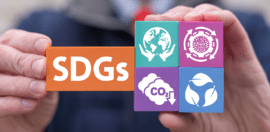How Australia Post brought its focus to sustainability

22 September 2021 at 3:39 pm
We sat down for a conversation with Susan Mizrahi, Australia Post’s chief sustainability officer, about how one of Australia’s most trusted brands approaches sustainability.
After spending four years as head of corporate responsibility for Australia Post, Susan Mizrahi became the business’s chief sustainability officer in 2019.
It was a role first established under the leadership of Christine Holgate and Nicole Sheffield, who worked to elevate the business’s sustainability credentials by bringing together the corporate responsibility and environmental sustainability teams.
Since Mizrahi took on the job, Australia Post has released its first Group Corporate Responsibility Plan, shifted to 100 per cent recyclable packing and created a carbon neutral deliveries program. It currently has over 3,000 electric delivery vehicles on the road.
We caught up with Mizrahi to discuss what the last couple of years have been like for her and her team, what sustainability looks like for Australia Post moving forward, and how they’re approaching the UN’s sustainable development goals (SDGs).
What is Australia Post’s approach to being a sustainable business?
We’re taking a holistic and very deliberate, strategic approach to sustainability. In 2016 we were one of the first Australian companies to embrace the SDGs, and they’ve acted as our north star. They’ve both underpinned and helped frame our approach to sustainability, and corporate responsibility, in recent years.
In 2020, we released our first Group Corporate Responsibility Plan, which covers off the social, environmental and governance dimensions [of the business] to ensure that we’re profiting responsibly.
It was the first public facing plan specifically related to our targets and our approach to sustainability that we’d ever laid out, and it held us to account both internally and externally. It laid the foundation for how we were going to drive value creation both socially and environmentally and how we would practice good governance, as a corporation.
We’re now two years into that plan and we’ve achieved a number of milestones.
Tell me a bit about those milestones…
One hundred per cent of our packaging is now recyclable and the vast majority of that is made with recycled content – we will be 100 per cent on both fronts by the end of this year, delivering on a pledge we made at the Australian Plastics Summit last year. We have offset 124 million parcels through our carbon neutral deliveries program with Qantas Future Planet. We’ve published a series of white papers to help support our customers, suppliers and partners to address the SDGs. The latest being a small business sustainability white paper, in partnership with the Banksia Foundation, that provides our small business partners and customers with a roadmap of how they can grow their business sustainably. We’ve published our fourth Reconciliation Action Plan, and achieved our enterprise target of 3 per cent Aboriginal and Torres Strait Islander employees. And we’re one of Australia’s first 13 companies to set a validated science based target, which is to address our scope one, two and three emissions. Australia Post also has Australia’s largest electric fleet for last mile delivery with over 3,000 electric delivery vehicles on the road, and we’re about to launch 20 new Fuso eCantor electric trucks into the Australian market — the first time those trucks are being used in Australia.
It sounds as if the work you’re doing in the SDG space is going very well. With so many businesses reported to be playing catch up with the SDGs, what’s Australia Post doing differently?
We’ve taken a really robust approach to the SDGs. Being a government business enterprise, our shareholder is the Australian government, and so when the goals were released, we felt that we had a moral obligation, not only as a large Australian business, but also as an extension of the Australian government to be doing the right thing in terms of helping to deliver on the goals.
The SDGs, as I said previously, were a north star for us but they’re not a utopian framework. They have commercial and strategic value. We wouldn’t have been able to sustain our CSR efforts if they weren’t proving to be popular, and profitable, with our people and our customers.
When the SDGs came out, we went through a comprehensive mapping exercise to look at our business strategy. This was around our impact as a business on the environment, society, customers etc and we also undertook stakeholder research as well. From that we identified a number of SDGs that we had the opportunity to influence directly, and some that we were influencing indirectly. For those that we had the opportunity to influence more directly we set aspirations for 2030.
One of the things that we’ve been doing is looking at the Australian government’s reporting platform on the SDGs and the indicators within that — those indicators inform the federal government’s periodic National Review to the UN. Of those 15, or so, indicators that we’ve been monitoring we are performing above the national average with respect to 13 of them.
What about the ones not performing so well?
Those are the ones that enable us to identify gaps and areas for improvement. For example, one that we haven’t been progressing as robustly as we’d like is renewable energy. And so we’ve stepped up our investment in that area.
Other than the federal government’s tool, how else do you track impact?
It depends on the metrics we’re talking about, there could be a flurry of information depending on which one. For example, we’ve been doing a lot around Aboriginal and Torres Strait Islander employment, and so the people and culture team track the data and the engagement of those employees in that space. We have a strategic community investment program that’s aligned to the themes of mental health, literacy and disaster resilience, and that’s led out of our community team. And then on the environmental front, our big focus areas are around emissions and waste reduction, increasing recycling and sustainable packaging and we have a really comprehensive program of work underpinning each of those areas and track that very carefully.
As Australia Post moves towards its validated science based target to reduce emissions by 15 per cent by 2025, how reliant is the business on a partner like Qantas to do the same?
Australia Post has a robust and strategic relationship with Qantas, it supplies us with our aircrafts, and their commitment to zero emissions by 2050 will only help us deliver on our efforts. That’s because about a third of our total emissions come from our delivery relationship with Qantas.
We’re always working with them to drive efficiencies in our shared freight services and, in addition to that work, we’ve partnered with Qantas Future Planet on our carbon neutrality for carbon neutral deliveries program. That means that, since October 2019, every parcel you send through a retail outlet or through MyPost’s business account is automatically carbon neutral as we offset the emissions of that delivery.
What does that look like on a practical level? Is it a financial donation, tree planting?
Qantas Future Planet has a suite of programs that a company like ours can invest in. We deliberately went through the different programs with an SDG lens, and aligned them back to our strategy. And so, we invest in a mix of domestic and international programs, including reforestation in New South Wales and Queensland and Indigenous fire management programs in the Northern Territory that help provide both an environmental impact and employment for Indigenous people up north. We are one of the top three purchasers of Indigenous offset programs in the country, which is something I’m quite proud of.
Australia Post’s Group Corporate Responsibility Plan states that it will establish a target of procuring $60 million through social enterprises and Indigenous businesses, between 2020 and 2022. How is that looking as we approach the end of 2021?
It’s looking very positive and we’re on track to achieve that target. For us it’s not about procuring more, it’s about doing it differently. An example of a procurement business we use, and one that I love, is called Nature Call, which is an Indigenous business providing ethical magpie removal services. With safety being our number one priority, swooping magpies can be a real hazard for our posties, and so we partnered with them to remove the magpies from delivery routes, relocate them and track their movements to ensure they settle appropriately in a new environment.
The Group Corporate Responsibility Plan we’ve been talking about only goes to the end of 2022, so what happens next?
We’re in the early stages of designing the new plan. We have a new CEO starting soon, who I hope will help us elevate our sustainability agenda and take it to the next level. We know that sustainability is of increasing importance to our customers and the broader Australian community. And, as one of Australia’s most trusted brands, we have a responsibility to help deliver a more sustainable future.
Environmental sustainability issues will only increase in importance, and our focus will continue to be around supply chain considerations and the environment. We’ll be looking at climate risk, sustainable packaging, waste and circular economy and then supply chain emissions around scope three but also sustainability considerations on the social side of supply chains in relation to modern slavery.
And I see a real opportunity for us to do more marketing for our great social and environmental initiatives, and to externally communicate the progress that we’ve made. I’d also love us to further engage our people so that they understand the role that they can play, particularly in relation to environmental sustainability.







